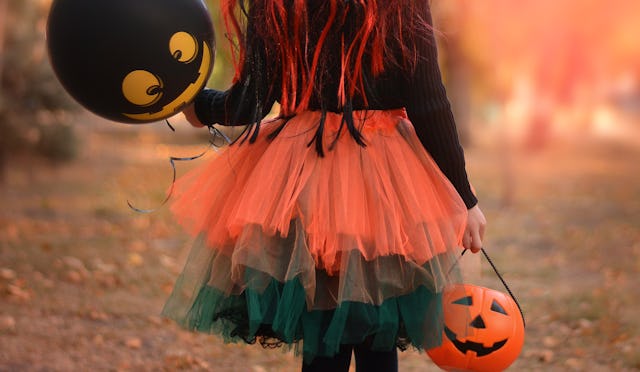When Can I Let My Kids Trick-Or-Treat Alone?
An expert weighs in on solo trick-or-treating age, plus tips for keeping everyone safe on Halloween.

Halloween has always been my favorite holiday. And during my childhood, trick-or-treating was the highlight. Now, as a parent, I'm thrilled to relive those magical moments with my own children, creating new memories along the way. But I know there will come the horrifying time when they ask to venture out on Halloween… without me.
If you've got kids who are already asking if they can trick-or-treat alone, well, there's not much I can do to fix your broken heart. However, these expert tips can help prepare them for a safe Halloween.
When can kids trick-or-treat without adult supervision?
Like many childhood milestones, readiness is going to depend on many factors. And in the case of kids being ready to trick-or-treat without adult supervision, it comes down to more than just age. According to Pattie Fitzgerald, safety expert and founder at Safely Ever After, right around the age of 12 is a good starting point for parents to begin considering if a child is ready for this big step. And she believes that it's the parent's responsibility to prepare them.
"We can't expect kids to simply know how to navigate a risky situation [...]. It's our job to teach them some street smarts," added Fitzgerald. Still, kids of any age are safest when trick-or-treating in a group, whether that's with one or more friends.
What should parents consider when deciding if their kids can trick-or-treat alone?
Your child's maturity level will be a good indicator of whether or not they're ready to be cut loose on Halloween night. But maturity isn't just about a child's ability to handle a dangerous situation; it's also about being able to follow rules. If you've seen the film Hocus Pocus and remember the neighborhood bullies, Jay and Ernie (aka Ice), you know that teens left unsupervised can often lead to some less-than-perfect behavior. So, beyond general safety, it's imperative to discuss that the rules for kindness still apply, even on Halloween night.
A few things to consider:
- Maturity. Is your child mature enough to interpret risky situations and execute an emergency strategy (e.g., ask for help or stick up for themselves)? Are they generally trusted to follow rules?
- Friends. Do you personally know the friends (and their parents) they'll be trick-or-treating with? It's essential to consider the demeanor of the kids in their group, as they can impact your child's behavior and decisions.
- Neighborhood. What's your community like? Is it urban with lots of foot and vehicle traffic? Is it a suburban area where everyone watches out for each other? There are risks in either setting, including a higher number of traffic accidents or a false sense of security.
- Time. Will your kids go out earlier in the evening before it's completely dark and while there are larger groups of families around that may be able to keep an eye on any troublesome situations?
What potential risks can children be exposed to when trick-or-treating without adult supervision?
Anytime children are out of the home without supervision, there's potential for risk. But because the nature of Halloween lends itself to situations where kids can be exposed to increased danger, parents need to be especially aware of overlooked potential scenarios.
Some risks to be aware of:
- Strangers or unauthorized persons inviting children into cars or homes or offering drinks or treats
- Traffic/pedestrian accidents (increased risk on Halloween)
- Aggressive adults or teens
How can parents prepare their children for trick-or-treating without adult supervision?
Simply thinking that a child is ready to be out on Halloween night (or anytime) unsupervised isn't enough to ensure their safety. A solid plan that includes safety gear, rules, and an emergency plan in the event that things go wrong is a necessity.
Tips for safe trick-or-treating:
- Take a cell phone along and have a code word or emoji for emergencies. Tracking devices like AirTags are good alternatives.
- Carry a flashlight or glow sticks, or try to incorporate bright colors into costumes.
- Stick to a planned route and stay in well-lit areas (no shortcuts through alleys, etc.).
- In case of emergency, ask an adult with children for help, or go to the nearest well-known friend's home or a public store.
- Trust your instincts. Say "no" and get help immediately if something doesn't feel right.
- Accept treats at doorways or porches only. Do not enter homes, go into backyards, or get into cars.
- Wait to eat candy at home after parents have checked it.
How to Give Kids a Little Independence Without Letting Them Go Unsupervised
It's natural to have a hard time giving up this fun tradition with your kids or letting them out of sight, especially if you don't feel they're ready to trick-or-treat unsupervised. Still, if you want to give them a little bit of independence or just test out their skills for the future, there's a simple way to ease up on the reins without going out of anybody's comfort zone.
"You don't have to accompany your child to every front door. Hang back on the sidewalk a bit so the kids feel a sense of independence," says Fitzgerald, suggesting to parents, "Accompany kids with a group of their friends and a few parents so that you aren't hovering over your child. Let the kids go up ahead a few houses at a time, as long as they're in your vision."